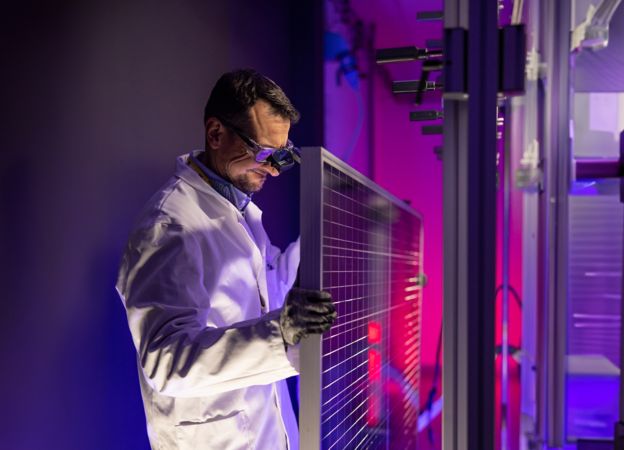~494 mln
attacks
(including automatic ones) against internet-exposed applications

Or , our new artificial intelligence tool.
We increase the efficiency and precision of our operations through the use of cutting-edge digital technologies, such as supercomputing and artificial intelligence.
Supercomputing and artificial intelligence are all the more indispensable for the competitiveness of our operations and the development of our decarbonisation technologies. The digital transformation involves every business activity and process, supporting our evolution to respond to the energy transition.
Digital geosciences, combined with the computing power of our supercomputers and our proprietary algorithms, allow us to maintain high efficiency in our exploration. Artificial intelligence (AI) is also increasingly being applied in an area as central to us as occupational safety, through tools that prevent and manage potentially critical situations. A further application of analysis methodologies through AI also concerns the preservation of the forest heritage, within the framework of our Carbon Offset Solutions.
By means of digital geosciences, we study the nature of the subsoil and pinpoint possible fields. We process data and information, reconstructing the geological characteristics of deep layers. We use the High Performance Computer layer 6 (HPC6), one of the most powerful and sustainable computers in the world, with which we are able to identify new natural gas reserves more efficiently and study new energy sources. Thanks to this supercomputer we can create three-dimensional models of the subsoil more quickly and study solutions to increase the efficiency of renewable energy.
A technological lever to accelerate Eni’s transformation and support the development of high-potential new businesses.


Our supercomputer allows us to expand geophysical exploration to quickly identify new fields.

Using HPC6, our researchers can learn about the subsurface in an increasingly precise and safe way.
Research programmes, applications and solutions to improve efficiency at every level.
In July 2024, we launched Eniquantic, a joint venture between Eni and IT Quanta, with the ambitious aim of developing an integrated machine combining both hardware and software, to solve complex problems (mathematical optimisation, modelling and simulation, artificial intelligence) and to initiate specific and significant applications of quantum computing in support of the energy transition.
We extended the Safety Pre-sense tool to all lines of business to increase worker safety. Using artificial intelligence, the system predicts recurring dangerous situations and implements corrective actions.
We use data analytics to support our strategic decisions such as, for example, in the area of bioenergy for biofuel production, by searching for marginal land where we can begin cultivation, as was the case for the first agri-hub in Kenya, set up to grow raw materials to be made into vegetable oil.
In addition, digitisation of processes is underway in CO2 offsetting activities, such as in the area of Carbon Offset Solutions, supporting REDD+ projects for forest conservation and protection.
Research programmes, applications and solutions to improve efficiency at every level.
In July 2024, we launched Eniquantic, a joint venture between Eni and IT Quanta, with the ambitious aim of developing an integrated machine combining both hardware and software, to solve complex problems (mathematical optimisation, modelling and simulation, artificial intelligence) and to initiate specific and significant applications of quantum computing in support of the energy transition.
We extended the Safety Pre-sense tool to all lines of business to increase worker safety. Using artificial intelligence, the system predicts recurring dangerous situations and implements corrective actions.
We use data analytics to support our strategic decisions such as, for example, in the area of bioenergy for biofuel production, by searching for marginal land where we can begin cultivation, as was the case for the first agri-hub in Kenya, set up to grow raw materials to be made into vegetable oil.
In addition, digitisation of processes is underway in CO2 offsetting activities, such as in the area of Carbon Offset Solutions, supporting REDD+ projects for forest conservation and protection.
Our main achievements when it came to preventing cyber attacks in 2022.
(including automatic ones) against internet-exposed applications
of phishing reported
malicious intercepted
In the field of robotics, mechatronics and automation, we have developed a system of innovative nanosensors to detect potential emissions in areas difficult to reach by personnel or other robotic means. We improved the Clean Sea submarine system, a robot that monitors submarine installations and water quality for CO2 capture and storage (CCS) activities. We use robots with legs and computer vision algorithms for industrial site inspections.

If you want to change topic, clear the chat and make a new query to receive more relevant results.
This will delete the question history.
If you want to change topic, clear the chat and make a new query to receive more relevant results. This will delete the question history.
Here you can find the full list of your queries.
The answers are generated by artificial intelligence, therefore they may contain inaccuracies. Please read the terms and conditions of use.

EnergIA is an innovative tool based on artificial intelligence capabilities, which can help you navigate the contents of eni.com, quickly finding answers to your questions. EnergIA can also perform a search on a specific topic, providing the most up-to-date data available, or it can invite you to delve deeper into a topic of your interest by suggesting links and specific readings. Start now!
EnergIA is an innovative tool based on artificial intelligence capabilities, which can help you navigate the contents of eni.com, quickly finding answers to your questions. Start now!
EnergIA (ener'dʒia) is a system based on Generative Artificial Intelligence.
Thanks to this technology, we can respond to your requests by querying the most relevant content and documents available on eni.com. (Note: financial documents from the last 12 months and press releases from the last 2 years are considered.)
Through EnergIA, you can delve into topics of interest and have a real-time window into the world of Eni.
If you wish to search for a specific document, press release or news, use the traditional search engine via the magnifying glass icon.
Like all systems that leverage Generative Artificial Intelligence, EnergIA may generate inaccurate or outdated responses. Always consult the sources that EnergIA proposes as the origin of the generated information.
If the system fails to find an exact match for the requested content, it still tends to provide a response.
If you find any inaccuracies in the provided response, please send us your feedback at the bottom of the page: it will be very helpful for us to improve.
Remember that the content generated by the system does not represent Eni’s official position. We therefore invite stakeholders to refer to their designated contacts for official statements: Press Office for journalists, Investor Relations for analysts and investors, Company Secretariat for shareholders etc..
EnergIA can understand questions posed in almost all languages, but we prefer to provide you with a response in English or Italian, the two languages available on eni.com. If you ask a question in Italian, the content on the site in Italian will be consulted. If you ask it in English or any other language, the content in English will be consulted. (Note: the language Eni uses for financial documents/content is predominantly English.)
If questions are formulated that violate the set security criteria, the system will not proceed with processing the response. Please remember not to send personal data.
By using this service, the users acknowledge that they have read and accepted the terms and conditions of use.
Search
EnergIA (ener'dʒia) is a system based on Generative Artificial Intelligence.
Thanks to this technology, we can respond to your requests by querying the most relevant content and documents available on eni.com. (Note: financial documents from the last 12 months and press releases from the last 2 years are considered.)
Through EnergIA, you can delve into topics of interest and have a real-time window into the world of Eni.
If you wish to search for a specific document, press release or news, use the traditional search engine via the magnifying glass icon.
Like all systems that leverage Generative Artificial Intelligence, EnergIA may generate inaccurate or outdated responses. Always consult the sources that EnergIA proposes as the origin of the generated information.
If the system fails to find an exact match for the requested content, it still tends to provide a response.
If you find any inaccuracies in the provided response, please send us your feedback at the bottom of the page: it will be very helpful for us to improve.
Remember that the content generated by the system does not represent Eni’s official position. We therefore invite stakeholders to refer to their designated contacts for official statements: Press Office for journalists, Investor Relations for analysts and investors, Company Secretariat for shareholders etc..
EnergIA can understand questions posed in almost all languages, but we prefer to provide you with a response in English or Italian, the two languages available on eni.com. If you ask a question in Italian, the content on the site in Italian will be consulted. If you ask it in English or any other language, the content in English will be consulted. (Note: the language Eni uses for financial documents/content is predominantly English.)
If questions are formulated that violate the set security criteria, the system will not proceed with processing the response. Please remember not to send personal data.
By using this service, the users acknowledge that they have read and accepted the terms and conditions of use.
A new window into Eni’s world, at your disposal. EnergIA is an innovative tool based on artificial intelligence capabilities, which can help you navigate the contents of eni.com, quickly finding answers to your questions.

